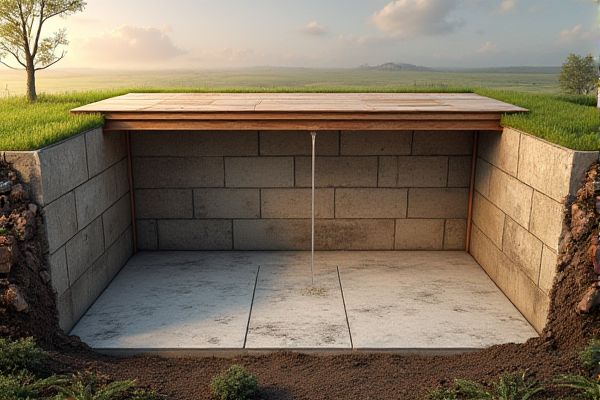
Slab foundations provide a solid, durable base with minimal maintenance, ideal for warmer climates, while crawl spaces offer easier access to plumbing and electrical systems but may require more upkeep to prevent moisture issues. Explore the full article to determine which foundation type best suits your home's needs and your lifestyle.
Table of Comparison
| Feature | Slab Foundation | Crawl Space |
|---|---|---|
| Construction | Concrete slab poured directly on ground | Elevated floor with a small space between ground and home |
| Cost | Lower initial cost | Moderate cost due to framing and ventilation |
| Moisture Control | Better moisture resistance if properly sealed | Requires ventilation and waterproofing to avoid dampness |
| Accessibility | Limited to no access under the home | Easy access for plumbing, wiring, and repairs |
| Insulation | Typically requires foam insulation under slab | Allows insulation beneath floors and walls |
| Durability | Highly durable with less risk of pest infestation | Potential for pest issues and moisture-related damage |
| Use Cases | Best for warm climates with stable soil | Ideal for sloped or unstable soil conditions |
Introduction to Slab Foundations and Crawl Spaces
Slab foundations are concrete slabs poured directly on the ground, providing a solid and stable base commonly used in warmer climates with minimal risk of frost heave. Crawl spaces elevate the home slightly above ground level, allowing access to plumbing and electrical systems while improving ventilation and insulation. Both foundation types serve specific structural and environmental needs, influencing construction cost, durability, and maintenance requirements.
Key Differences Between Slab and Crawl Space Foundations
Slab foundations are concrete slabs poured directly on the ground, providing a solid base that eliminates the need for a basement or crawl space, while crawl space foundations elevate the home off the ground with space underneath for access to plumbing and wiring. Slab foundations offer better resistance to termite infestations and flooding but can be more challenging and costly to repair if plumbing issues arise beneath the concrete. Crawl spaces facilitate easier access for maintenance and repairs, improve ventilation, and allow for insulation beneath the home's floor, though they may be prone to moisture problems without proper ventilation and waterproofing.
Pros and Cons of Slab Foundations
Slab foundations offer excellent durability and resistance to termites and moisture, making them ideal for warm climates and areas with high water tables. They provide cost-effective construction and require less maintenance compared to crawl space foundations. However, slab foundations can be prone to cracking, offer limited access to plumbing and electrical systems, and may cause discomfort in colder climates due to poor insulation.
Pros and Cons of Crawl Space Foundations
Crawl space foundations offer benefits such as easy access to plumbing, electrical wiring, and HVAC systems, which simplifies repairs and renovations. These foundations also provide better ventilation than slab foundations, reducing moisture buildup and potential mold issues under the house. However, crawl spaces can be prone to pests, require regular maintenance to prevent moisture problems, and may not be ideal for areas with high water tables or poor drainage.
Cost Comparison: Slab Foundation vs Crawl Space
Slab foundation typically costs between $4,000 and $12,000, making it more affordable due to less labor and materials compared to crawl space foundations, which range from $8,000 to $25,000. Crawl space foundations require additional expenses for ventilation, moisture barriers, and access points, increasing overall installation and maintenance costs. Homeowners often choose slab foundations for budget efficiency, while crawl spaces offer added benefits like easier access to plumbing and electrical systems despite higher initial investment.
Climate and Soil Considerations for Foundation Choice
Slab foundations are ideal for warm climates with stable, well-draining soils, reducing risks of frost heave and moisture intrusion. Crawl spaces suit regions with expansive clay or poorly draining soils by elevating the structure, facilitating ventilation and access to utilities. Evaluating local frost depth, soil composition, and drainage is critical in selecting the appropriate foundation to ensure structural integrity and longevity.
Energy Efficiency: Slab vs Crawl Space
Slab foundations provide superior energy efficiency by minimizing air leaks and reducing heat loss through direct contact with the ground, which helps maintain consistent indoor temperatures and lowers heating and cooling costs. Crawl spaces often require additional insulation and ventilation to prevent moisture buildup and temperature fluctuations, making them less efficient in energy conservation. Your choice between slab and crawl space foundations will directly impact your home's energy performance and utility expenses.
Maintenance and Longevity of Each Foundation Type
Slab foundations require minimal maintenance due to their solid concrete base, reducing risks of pests and mold but can be prone to cracking over time if the soil shifts. Crawl space foundations offer easier access to plumbing and electrical systems for maintenance, though they demand regular inspections to prevent moisture buildup and potential wood rot. Your choice impacts long-term upkeep costs and structural durability, influencing the overall lifespan of your home's foundation.
Resale Value and Market Preferences
Homes with slab foundations often appeal to buyers seeking lower maintenance and modern construction, potentially boosting resale value in warmer climates. Crawl space foundations can attract buyers valuing easier access to utilities and better ventilation, which may enhance market appeal in regions with high moisture or colder temperatures. Real estate trends show regional preferences significantly impact resale value, with slab foundations favored in the South and Southwest, while crawl spaces remain popular in the Pacific Northwest and parts of the Northeast.
How to Choose the Right Foundation for Your Home
Choosing the right foundation for your home depends on factors like soil type, climate, and budget. A slab foundation offers durability and cost-efficiency for stable, warm climates, while a crawl space provides easier access to plumbing and electrical systems, ideal for areas prone to moisture or flooding. Evaluate your site conditions and long-term maintenance needs to determine whether a slab foundation or crawl space best supports your home's structural integrity and comfort.
 homyna.com
homyna.com